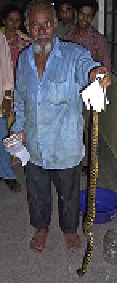Biology Reference
In-Depth Information
Plate 4.65
Checkered or painted keel-back (
Xenochrophis piscator
), Chittagong,
Bangladesh.
The
X. piscator/Xenochrophis flavipunctatus
complex is a group of natricids
that widely range in Asia. The complex has been subject to repetitive taxonomic revision
(Vogel and David, 2006), and may contain eight or more species. The pictured specimen was
brought to a medical clinic by the bitten victim. There were no medically significant effects.
Harmless species such as
X. piscator
are greatly feared in some communities as bites from
any snake may be considered tantamount to a death sentence. Such fears may contribute to the
somatic amplification of mild local effects or exacerbations of the victim's preexisting medical
conditions (see Section 4.5). Photo copyright to Richard Maude.
incidence decreased except for a brief secondary peak during October. There were
two peaks of biting incidence during the day, at 0800-1200 h and at 1800-2100 h.
Only 2% of bites involved sleeping subjects. Eighteen of the snakes brought for
identification were non-front-fanged colubroids: one
X. piscator
, four
C. radiatus
,
and 13
L. aulicus
. All four
C. radiatus
bites were on the feet during the evening and
caused pain and bleeding at the bite site. Ligatures had been applied to all four vic-
tims, and they reached the hospital between 1.5 and 4 h (mean 3 h) after the bite.
Fifty-five percent of bites by
L. aulicus
involved the feet, and 45% involved the
hands. Sixty-six percent occurred indoors. All subjects experienced pain and bleed-
ing at the bite site, and ligatures were used in all cases. All patients were admitted to
the hospital between 1.5 and 6 h (mean 4 h) after the bite (Harris et al., 2010).
4.1.1.4 Thailand
A national survey of cases of snakebites in which the snakes were available for iden-
tification collected 1,631 snakes responsible for bites, of which 490 were neither
elapids nor viperids (Viravan et al., 1992). Twenty-two non-front-fanged colubroid
species were involved, including
Rhabdophis subminiatus
,
C. radiata
,
Homalopsis
buccata
(
Plate 4.66
),
Oligodon
(
Plate 4.67A and B, kukri snakes
),
Lycodon
,
Boiga
,
and
Enhydris
spp. (Plate 4.21A and B). None of the patients developed any significant
signs of local or systemic envenoming, but in 22 cases medical staff misidentified the
snakes as venomous, leading to inappropriate use of antivenom. The five patients bit-
ten by
R. subminiatus
had accidentally trodden upon or touched the snake. Apart from
bleeding from the bite wound, there were no adverse effects (
Table 4.1
).

